Armory Models 1/48 Fairey Flycatcher (early production)
History:
The Fairey Flycatcher holds the honor of being the first designed-for-the purpose single-seat carrier-borne fighter to enter production. It served the Fleet Air Arm from 1923-1935, and was remembered with affection by the pilots who flew it. One, Air Commodore G.J. Christopher Paul, who was later Manager of "Air Pictorial" following retirement from active service, wrote of the Flycatcher, "It was a small and very responsive aeroplane, in which the pilot seemed only to have to think a maneuver for the Flycatcher to follow his thoughts."
By 1922, the British armed forces had been severely reduced in the aftermath of the First World War. Since 1919, British naval air strength amounted to one spotter-reconnaissance squadron, half a torpedo squadron, one fighter flight, one seaplane flight, and one flying boat flight. Between 1919-22, HMS "Argus" was the only carrier in commission. The aircraft aboard were the Sopwith Cuckoo, the Parnall Panther, the Westland Walrus and the Nieuport Nightjar - all aircraft whose designs had originated during the war. In fact, Sopwith Camels were flown from "Argus" as late as 1920.
The RAF had been created by the amalgamation of the Royal Flying Corps and the Royal Naval Air Service in 1918; consequently, the Royal Navy did not have its own air force, and flying personnel were from the RAF. The Admiralty might suggest ideas for aircraft specifications, but the design and production of naval aircraft were the responsibility of the Air Ministry. This was unfortunate, since it would result in British naval aircraft always being somewhat obsolete and second-rate, carrier-borne modifications of land-based designs that were not conceived with the problems of carrier operation in mind. The worst example of this would be the Sea Spitfire, which was so manifestly wrong for operation from an aircraft carrier on any grounds other than force majeure that five times as many would be lost to carrier operation accidents as to actual operations.
In 1922, the Air Ministry was prevailed upon to issue Specification 6/22, calling for a single seat fighter that would be capable of operating from carriers, on floats, or as an amphibian, to be powered by either the Bristol Jupiter or Armstrong-Siddeley Jaguar radial engines. Fairey Aircraft presented the Flycatcher in response. The other competitor was the Parnall Plover, which had a comparable performance but - due to the fact it was of all-wooden airframe construction - did not have the rugged strength of the Flycatcher, which was of mixed wood and metal airframe construction, with wooden wings and a wood-and-metal fuselage frame.
The prototype Flycatcher, powered by a 400 h.p. Jaguar radial, was first flown in mid-1922 by Lt. Col. Vincent Nicholl. Having completed service trials at Martlesham Heath, it went aboard "Argus" for deck-handling trials. At this time, it was equipped with steel jaws on the spreader bar to engage the fore-and-aft arrester wires then in use. Flycatchers would use this system until it was abandoned in 1926, after which they would not use any arresting device. By the time transverse wires were introduced, the Flycatcher had been supplanted by the Hawker Nimrod.
For its time, the Flycatcher exhibited excellent performance, though its maximum speed of 133 m.p.h. at 5,000 ft. was not substantially more than that of the fighters of the last years of World War I. The airplane had outstanding aerobatics and ease of handling, being described as “... having the handling of a Pup and the performance of a Camel.” Its wingspan of 29 feet enabled it to be raised and lowered on the deck elevator without need of wing folding. As with other Fairey aircraft, it used camber-changing wings in which flaps ran the span of the upper and lower wings - with the outer sections doubling as ailerons - which steepened the glide path and shortened both landing and take-off runs. In tests at Martlesham Heath, with no wind and a zero flap setting, the unstick distance was 363 feet; with a flap setting of 8 degrees, this was reduced to 199 feet! With 8 degrees of flaps, landing speed was 47 m.p.h. Stability was so good that the airplane could be dived vertically at terminal velocity with no danger of overstressing it on pullout. Flycatchers wowed the audience at the Hendon Displays of 1928 and 1929, in which 3 Flycatchers attacked the same target simultaneously, diving from 2,000 feet from three different directions.
Together with the Fairey IIIF, the Flycatcher served in every active aircraft carrier between 1923-35, with the Home Fleet, the Mediterranean Fleet and the China Station. Floatplane Flycatchers were used on the China Station and the East Indies Squadron until 1934, and were very active against Chinese pirates raiding coastal shipping near Hong Kong. A Flycatcher made the first-ever night landing aboard a carrier, flying from Hal Far, Malta, to H.M.S. "Courageous" on November 26, 1929.
In 1929, Flying Officer P.D. Cracroft, while flying with 405 Flight aboard H.M.S. Glorious observed from the air a division of destroyers operating in low sea fog that were headed straight toward another formation to the other side of the fog bank. Since he did not have a radio to warn anyone of the danger, he deliberately ditched his aircraft alongside the flotilla to draw their attention to the danger ahead.
193 Flycatchers were eventually produced, in production batches ordered in August 1924 and 1925, and March 1930. The Flycatcher served only with the RAF. Though no original aircraft survive, a full-scale replica was created during the 1980s and flown successfully.
The Kit:
The Flycatcher was originally produced in 1/48 by the British model company, Inpact, appearing in the 1960s, along with the Gloster Gladiator I, the Hawker Fury I, and the Bristol Bulldog. Like the others, it was later released by Lifelike, Pyro, and eventually Lindberg.
This kit from Ukrainian company Armory Models Group is their first full kit in 1/48. Kits 48002, 48003 and 48004 are, respectively, the late production Flycatcher and the Flycatcher floatplane fighter on wooden and metal floats.
The kit is fairly obviously a labor of love by the designer. It is what one would expect with the improvement in design and production capabilities between this and a kit first designed 60 years ago. All control surfaces are separate. The fabric-covered areas are done realistically; even the area of the “turtleback” and the lower rear fuselage that I though was overdone are in fact not overdone when period photos are consulted. The cockpit is more than fully-detailed with a number of very small, delicate parts that can be classified as “I don't care of you can't see them, I know they're there.” Photo-etch is used for many of these small parts. The engine is done in resin with good detail. Comparing the completed model to one of the earlier Inpact Etc. models, this is far more petite - the early kit seems klunky in comparison, and it was one of the better in that series.
The decals provide markings for all the fighter flights aboard carriers between 1924-30. These are very nice decals, with good opacity and crisp design.
Construction:
This is not a project for the biplane-phobic or the inexperienced. It's another of those “high level limited run kits” that Ukrainian model companies are doing these days. Pay attention to the latter, and the result will be the former.
I started with the cockpit. I limited myself to the plastic parts, assembling the interior frame in plastic, and not worrying overmuch about the small p-e parts, since if you finish with the side flaps up (as I did) you won't notice them. Once assembled, the frame was painted gloss black. The interior of the fuselage was done in light grey for the aluminum areas of the forward section, with the aft section in Hull Red to simulate the red dope the fabrid was treated with. I substituted and Eduard WW1 Sutton Harness for the kit parts since the Eduard is pre-painted and overall looks better.
The fuselage came together without problem; I used some CA glue to disappear the centerline seam I particularly liked that the lower rear fuselage was a separate part, so there was no centerline seam to worry about. The tail was assembled with the elevators drooped and the rudder left off until it was decaled.
I assembled the wings with the ailerons/flaps lowered, mostly because the kit allows you to do that and it provides an interesting look. I substituted plastic control horns made from .020 Evergreen sheet for the very thin photoetch parts.
I assembled the landing gear, but left it off until painting was completed.
Colors and Markings:
I gave the forward metal covered section of the fuselage a primer of Tamiya X-1 “Gloss Black.” The rear fuselage, tail and wings were primered with Tamiya X-18 “Semigloss Black.” I used Vallejo “Aluminum” for the forward part of the fuselage, to give a polished metal look, and used Vallejo “White Aluminum” to simulate aluminum dope.
When the paint was dry, I attached the landing gear and other detail parts.
The resin engine was painted with Tamiya X-18 “Semigloss Black.” I opted for the large spinner because it looks good and also hides the fact that many of the small photoetch parts were not used. I also substituted Evergreen .010 and .015 plastic rod for the ezhaust stubs rather than using the very fragile resin parts, after the first three broke taking them off the pour stubs.
I used the kit decals to do a Flycatcher of 405 Flight aboard HMS Furious in 1929, which I thought was the overall most-colorful option. The decals went down under a coat of Micro-Sol without problem.
The model was rigged with Precious Metal 0.33mm nickel steel wire. I use pieces of Evergreen .010 x .020 plastic strip to assemble the double flying wires before attaching them to the model, which allowed me to get them better aligned than doing that separately.
Conclusions:
This kit by Armory is definitely the best model available of the world's first designed-for-the-purpose carrier fighter. If you take your time and study the instructions carefully, you can get a very nice result.
Recommended for modelers who are: a.) experienced with limited run kits, b.) experienced with biplane models, and c.) a fan of naval aviation. This is a very worthwhile addition to any collection of historically-important naval aircraft.
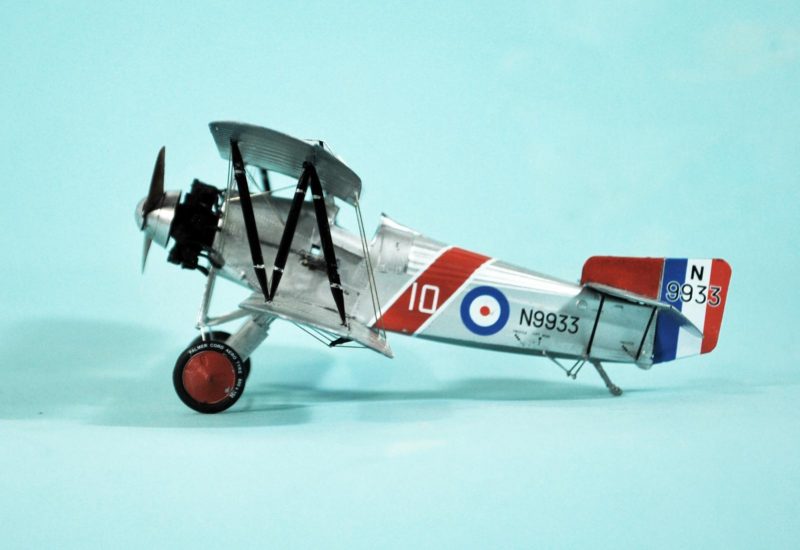
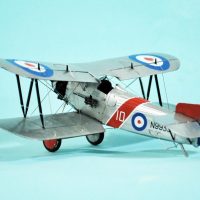
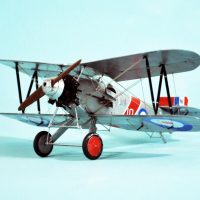
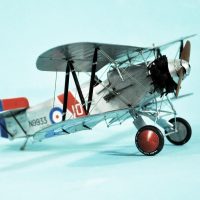
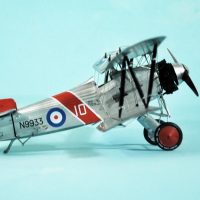
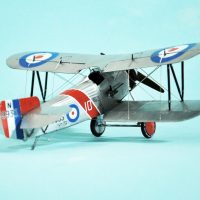
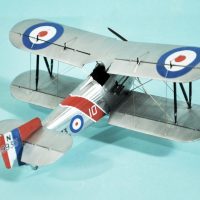
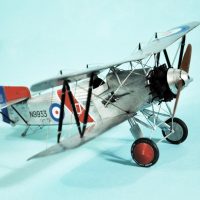
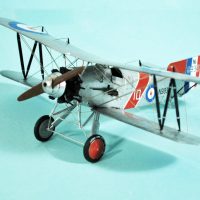
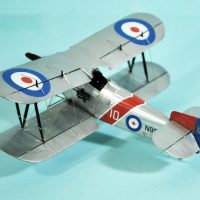
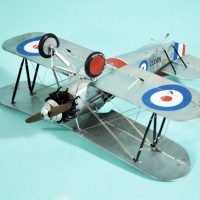
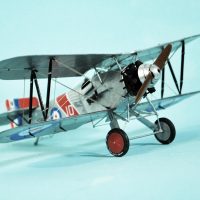
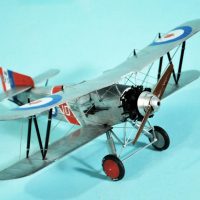
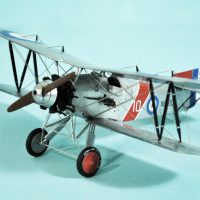
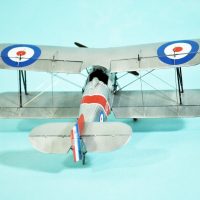
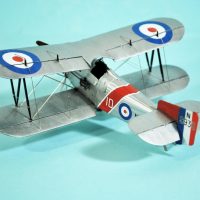


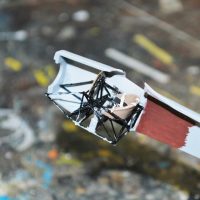
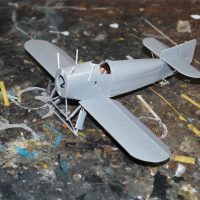
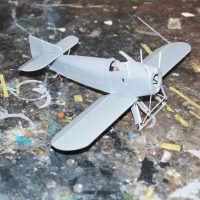
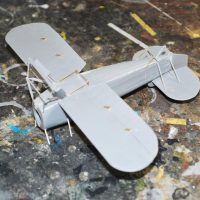
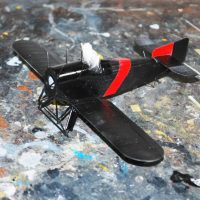
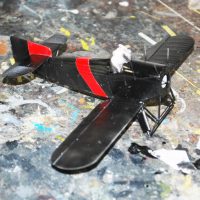

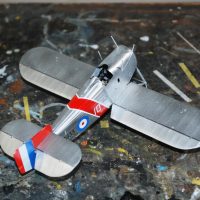

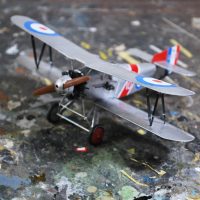
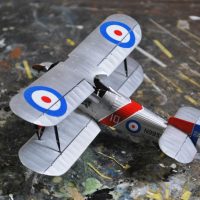
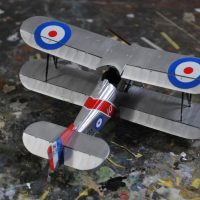
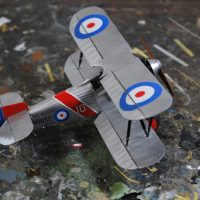
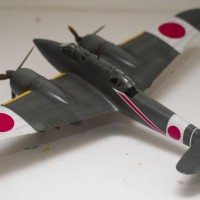
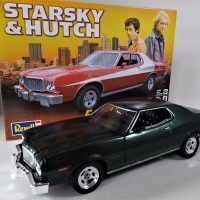
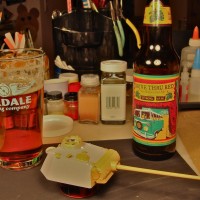
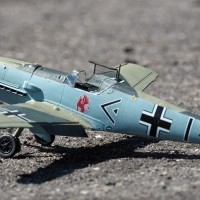
As usual, nice build. Interesting history on this aircraft, I did not know it went back so close to World War I. While doing a search for 1/48 Flycatcher I found your review of the Lindbergh Flycatcher from 2003. Both builds looks great, It is amazing it took so long for a better kit to be released.
Excellent build and an equally excellent review, Tom!
Great looking build Tom.
Weird little plane, with it's tail sticking up. Looks like it landed hard and bent up in the middle.
I can't believe how fast you work. Something like this would take me months, if it ever got done at all. Great work.
Took me about 30 hours over 2 months.
Nice work, Tom. The Flycatcher is one of my favorites. The lettering on the tires is a nice detail. I wish one of these newer companies would do some interwar USN subjects in 1/48.
Looks great Tom! I don't think I'll try to tackle one of those in 1/72...
Very nice work on this bi-plane, Tom.
Looks great in this finish.
Great work Tom. Very sharp looking result.
Nice work Tom, on a kit that doesn't look to be for the faint of heart.
Excellent model. I really like the color scheme.
Before WnW imploded, this is kind of where I was hoping they would go (between the wars) once they went through the WW1 stuff.
Blah, blah,blah nice, blah blah etc...THAT RIGGING! 🙂
Wonderful model making work on a highly interesting subject, congratulations!
Great job Tom. Very interesting subject. Thanks for the history along with the kit.
As usual Tom, your background stories flesh out the model. I remember the Inpact models & built the Gladiator many years ago. Your Flycatcher is a gorgeous labor of love, and it shows. The 'think' level of responsiveness for aerobatics is most apparent. You've captured it all!
Great job, Tom! Now I want one!
You have your choice of four - landplanes, seaplanes, early, late.